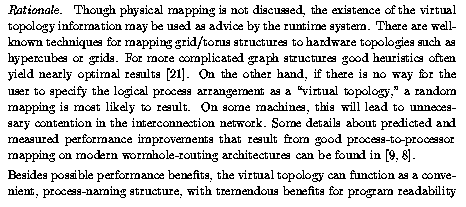This chapter discusses the MPI topology mechanism. A topology is an extra, topologyattribute, topology topology and intercommunicator optional attribute that one can give to an intra-communicator; topologies cannot be added to inter-communicators. A topology can provide a convenient naming mechanism for the processes of a group (within a communicator), and additionally, may assist the runtime system in mapping the processes onto hardware.
As stated in Chapter ![]() ,
a process group in MPI is a collection of n processes. Each process in
groupprocess group
the group is assigned a rank between 0 and n-1. In many parallel
applications a linear ranking of processes does not adequately reflect the logical
communication pattern of the processes (which is usually determined by the
underlying problem geometry and the numerical algorithm used). Often the
rankprocess rank
processes are arranged in topological patterns such as two- or
three-dimensional grids. More generally, the logical process arrangement is
described by a graph. In this chapter we will refer to this logical process
arrangement as the ``virtual topology.''
,
a process group in MPI is a collection of n processes. Each process in
groupprocess group
the group is assigned a rank between 0 and n-1. In many parallel
applications a linear ranking of processes does not adequately reflect the logical
communication pattern of the processes (which is usually determined by the
underlying problem geometry and the numerical algorithm used). Often the
rankprocess rank
processes are arranged in topological patterns such as two- or
three-dimensional grids. More generally, the logical process arrangement is
described by a graph. In this chapter we will refer to this logical process
arrangement as the ``virtual topology.''
A clear distinction must be made between the virtual process topology and the topology of the underlying, physical hardware. The virtual topology can be exploited by the system in the assignment of processes to physical processors, if this helps to improve the communication performance on a given machine. How this mapping is done, however, is outside the scope of MPI. The description of the virtual topology, on the other hand, depends only on the application, and is machine-independent. The functions in this chapter deal only with machine-independent mapping. topology, virtual vs physical

and notional power in message-passing programming (End of rationale)